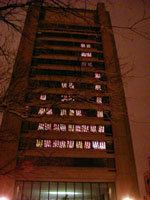 Joy Of Tech posts a comic that at first sight might remind you of our project but a second look reveals that this might be in reminiscence of the „La Bastille“ installation running at Brown University in Providence, Rhode Island in April 2000.
Joy Of Tech posts a comic that at first sight might remind you of our project but a second look reveals that this might be in reminiscence of the „La Bastille“ installation running at Brown University in Providence, Rhode Island in April 2000.
The Blinkenlights Links page provides even more pointers to other similar installations. Among them you find the first tetris game on a building at TU Delft in 1995 and the first VU meter on a building in Boston in 1993. These two can be considered being the real pioneers of this idea. We brought Tetris to life as well in our Arcade installation in Paris last year and there was also a real-time visualization of sound as you can see in our documentation video.
Project Blinkenlights however was the first to combine interactivity with mobile phones and the first to provide an open-sourced control software with well-defined file formats (BLM and BML) and a plug-in API for interactive games.
The Blinkenlights software will be enhanced over time and you are invited to write new modules for it. Sven provides the most recent updates on his page and has also started writing the documentation for the Blinkenlights Library.
